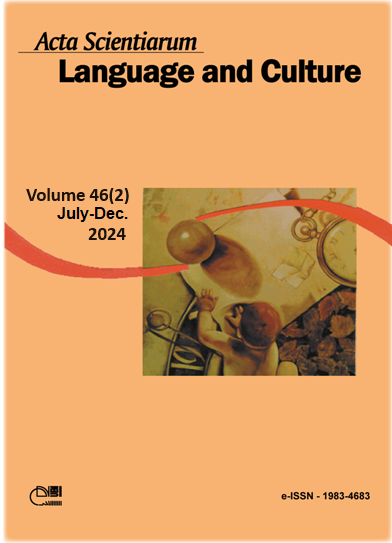Sertão, espaço de germinação poética topofílica e biofílica em Patativa do Assaré: uma abordagem ecocrítica
Resumen
Frente aos problemas ambientais enfrentados em nossa contemporaneidade, socioambientalistas de todo mundo se mobilizam com o objetivo de pensar a relação ser humano-natureza. Em vista disso, surgiram estudos sistemáticos e interdisciplinares na tentativa de questionar a condição utilitarista dos bens naturais como recursos não renováveis. Desse modo, pretendeu-se ampliar as discussões sobre a Ecocrítica como articuladora desta interdisciplinaridade. O conceito da teoria literária Ecocrítica contribuiu para as análises de nossa pesquisa. Para tal feito, o objetivo desta pesquisa foi analisar a relação ser humano-natureza na poética de Patativa do Assaré, a qual tematiza a Literatura e a Ecologia, pautadas na corrente crítica Ecocrítica. Assim, as análises poéticas concorrem para a compreensão sobre o sertão nordestino como espaço onde brotam a semente e as rimas que expressam os sentimentos topofílicos e biofílicos. Como resultados obtidos a partir das análises das poesias, pôde-se observar que a poética patativiana se consolidou como espaço sertanejo no qual floresce rimas no mesmo ritmo que a natureza floresce e, por fim, uma literatura topofílica e biofílica e, para tal, uma nova ressignificação da relação sujeito-natureza. Concluiu-se que a Ecocrítica se tornou uma importante ferramenta de análise do texto literário, permitindo perceber uma ressignificação do ser humano-natureza. Em específico, a poética de Patativa do Assaré permite olhar o lugar, o ser e a existência numa unicidade, sendo assim, em um tríplice aspecto indissociável.
Descargas
Citas
Referências
Araújo, E. J. P., & Santos, S. M. P. (2020). As representações do sertão em Inspiração Nordestina de Patativa do Assaré. In Anais do XVIII Congresso Internacional ABRALIC - Associação Brasileira de Literatura Comparada (p. 3966-3977). Salvador, BA.
Arvay, C. G. (2016). El efecto biofilia: el poder curativo de los árboles y las plantas. Barcelona, ES: Urano.
Assaré, P. (1978). Cante lá que eu canto cá: filosofia de trovador nordestino. Petrópolis, RJ: Editora Vozes.
Assaré, P. (2003). Inspira não nordestina. São Paulo, SP: Hedra.
Assaré, P. (2005). Ispinho e fulô. São Paulo, SP: Hedra.
Bachelard, G. (2000). A poética do espaço. São Paulo, SP: Martins Fontes.
Brito, A. I. A (2018). Uma Voz que amplifica a aldeia: as imagens do sertão na obra de Patativa do Assaré – do corpo as novas mídias (Tese de Doutorado). Pontifícia Universidade Católica de São Paulo, São Paulo.
Camasca, E. (2020). Ecocrítica y poesía política en Cenizas en la aurora (Tese de Doutorado). Universidad Nacional Mayor de San Marcos, Lima, Perú.
Candido, A. (2007). Formação da Literatura Brasileira: momentos decisivos. Rio de Janeiro, RJ: Ouro Azul.
Candido, A. (2011). O direito à literatura. In A. Candido, Vários escritos (p. 171-193). Rio de Janeiro, RJ: Ouro Azul.
Carvalho, G. (2002). Patativa poeta pássaro do Assaré. Fortaleza, CE: Editora Inside.
Carvalho, G. (2009). Cem Patativa. Fortaleza, CE: Omni.
Carvalho, G. (2011) Patativa do Assaré: um poeta cidadão. São Paulo, SP: Editora Expressão Popular.
Cidreira-Neto, I. R. G., & Rodrigues, G. G. (2017). Relação homem-natureza e os limites para o desenvolvimento sustentável. Revista Movimentos Sociais e Dinâmicas Espaciais, 6(2), 142-156. DOI: https://doi.org/10.51359/2238-8052.2017.231287.
Feitosa, C. N. C., & Silva, J. C. (2020). Aspectos ecológicos no poema Eu e Meu Campina, de Patativa do Assaré: uma abordagem ecocrítica. Brazilian Journal of Development, 6(4), 18517-18536. DOI: https://doi.org/10.34117/bjdv6n4-138.
Feitosa, L. T. (2009). Digo e não peço segredo. São Paulo, SP: Escrituras.
Garrard, G. (2006). Ecocrítica. Brasília, DF: Editora Universidade de Brasília.
González, M. O. (2010). Globalización, ecologia y literatura. Aproximación ecocrítica a textos literários latino-americanos. Kipus: Revista Andina de Letras, 27(I Semestre), 97-109.
Grinde, B., & Patil, G. G. (2009). Biophilia: does visual contact with nature impact on health and well-being? International Journal of Environmental Research and Public Health, 6(9), 2332-2343. DOI: https://doi.org/10.3390/ijerph6092332.
Morin, E., & Kern, A. B. (2011). Terra-pátria. Porto Alegre, RS: Sulina.
Norton, B. G., & Bravo-Osorio, F. (2019). Ética ambiental y antropocentrismo débil. Humanitas Hodie, 2(2), 1-22. DOI: https://doi.org/10.28970/hh.2019.2.a4.
Pilati, A. (2018). Poesia na sala de aula: subsídios para pensar o lugar e a função da literatura em ambientes de ensino. Campinas, SP: Pontes Editores.
Santos, J. S., & Lima, T. C. (2020). O elo entre a pessoa e o lugar: a afetividade, o sentimento de pertencimento e a memória dos moradores do povoado Baixão do Pará, Município de Gonçalves Dias – MA. Geografia: Publicações Avulsas, 2(1), 274-291.
Seemann, J. (2007). Geografia, geograficidade e a poética do espaço: Patativa do Assaré e as paisagens do Cariri (Ceará). Ateliê Geográfico, 1(1), 50-73. DOI: https://doi.org/10.5216/ag.v1i1.2714.
Speranza, A. (2006). Ecologia profunda y autorrealización: introdución a la filosofía ecológica de Arne Naess. Buenos Aires, AR: Biblos.
Tortonda, A. P. (2018). El estudio y la didáctica de la literatura desde una perspectiva ecocrítica y sus nexos con la educación ambiental, patrimonial y de género (Tese de Doutorado). Universidad de Extremadura, Badajoz.
Tuan, Y.-F. (2018) Topofilia: um estudo da percepção, atitudes e valores do meio ambiente. São Paulo, SP: Difel.
Wilson, E. O. (1984). Biophilia: the human bond with other species. Cambridge, MA: Harvard University Press.
DECLARAÇÃO DE ORIGINALIDADE E DIREITOS AUTORAIS
Declaro que o presente artigo é original, não tendo sido submetido à publicação em qualquer outro periódico nacional ou internacional, quer seja em parte ou em sua totalidade.
Os direitos autorais pertencem exclusivamente aos autores. Os direitos de licenciamento utilizados pelo periódico é a licença Creative Commons Attribution 4.0 (CC BY 4.0): são permitidos o acompartilhamento (cópia e distribuição do material em qualqer meio ou formato) e adaptação (remix, transformação e criação de material a partir do conteúdo assim licenciado para quaisquer fins, inclusive comerciais.
Recomenda-se a leitura desse link para maiores informações sobre o tema: fornecimento de créditos e referências de forma correta, entre outros detalhes cruciais para uso adequado do material licenciado.




















6.png)









